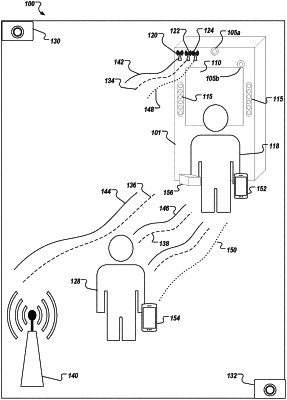| CPC G06F 21/32 (2013.01) [G06V 10/764 (2022.01); G06V 10/82 (2022.01); G06V 40/103 (2022.01); G06V 40/12 (2022.01); G06V 40/171 (2022.01); G06V 40/172 (2022.01); G06V 40/18 (2022.01); G06V 40/20 (2022.01); G06V 40/25 (2022.01); G06V 40/70 (2022.01)] | 20 Claims |

|
1. A computer-implemented method for authenticating biometric data of a user at a device using a feature vector, the method being executed by one or more processors and comprising:
identifying a target user in proximity to the device;
detecting, using equipment on or in proximity to the device, a wireless signal, the equipment capable of proximity sensing the wireless signal that passed through a body of the target user, a wireless signal that deflected off the body of the target user, and a wireless signal that both passed through and deflected off the body of the target user, wherein the equipment transmits an identifier;
processing the wireless signal to identify a unique effect of the body of the target user on the wireless signal and generate the feature vector for the target user, the feature vector based on the effect of the body and including at least motion characteristics including gait characteristics of the target user as the target user approaches the device, wherein the unique effect of the target user creates an apparition in the wireless signal, by which each target user has a unique apparition effect and is identified by the unique apparition effect;
determining a candidate user to compare to the target user;
retrieving reference data for the candidate user;
comparing the feature vector to the reference data for the candidate user to determine a likelihood that the target user is the candidate user; and
customizing a device application for the target user based on the determined likelihood and once a target user is identified, tracking a location and a direction of travel with speed for the target user by receiving subsequent wireless signals.
|